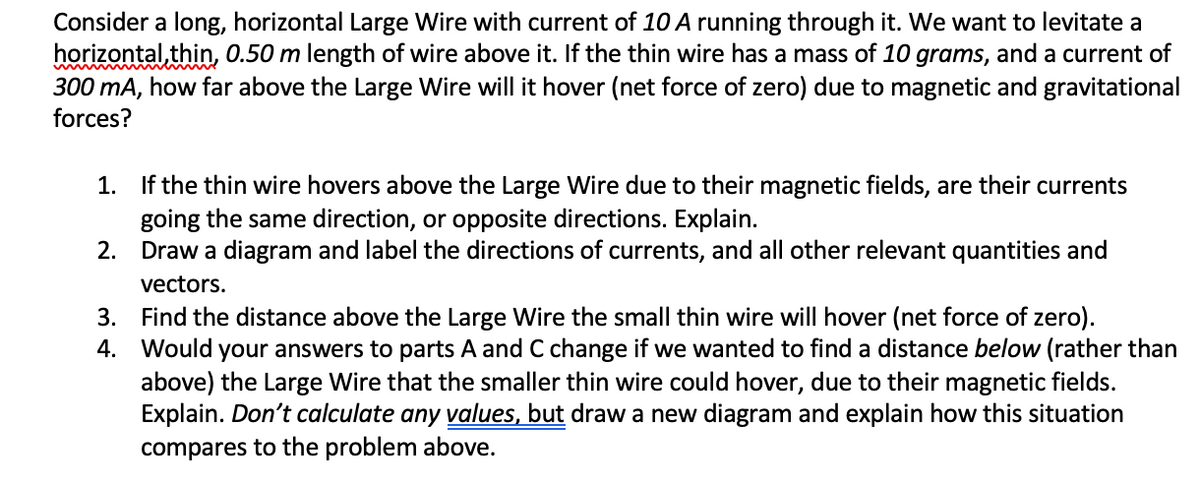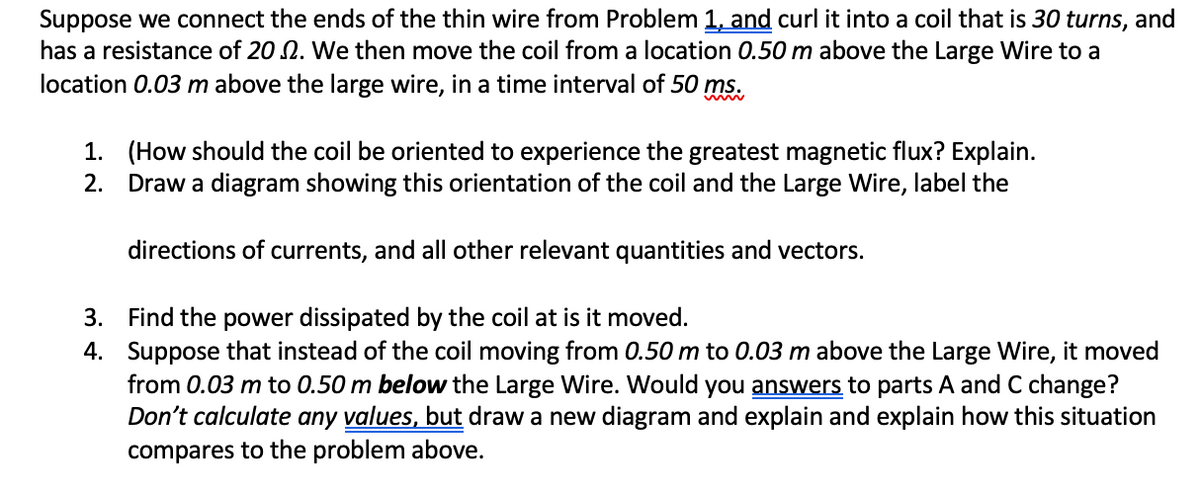Consider a long, horizontal Large Wire with current of 10 A running through it. We want to levitate a horizontal,thin, 0.50 m length of wire above it. If the thin wire has a mass of 10 grams, and a current of 300 mA, how far above the Large Wire will it hover (net force of zero) due to magnetic and gravitational forces? 1. If the thin wire hovers above the Large Wire due to their magnetic fields, are their currents going the same direction, or opposite directions. Explain. 2. Draw a diagram and label the directions of currents, and all other relevant quantities and vectors. 3. Find the distance above the Large Wire the small thin wire will hover (net force of zero). 4. Would your answers to parts A and C change if we wanted to find a distance below (rather than above) the Large Wire that the smaller thin wire could hover, due to their magnetic fields. Explain. Don't calculate any values, but draw a new diagram and explain how this situation compares to the problem above.
Consider a long, horizontal Large Wire with current of 10 A running through it. We want to levitate a horizontal,thin, 0.50 m length of wire above it. If the thin wire has a mass of 10 grams, and a current of 300 mA, how far above the Large Wire will it hover (net force of zero) due to magnetic and gravitational forces? 1. If the thin wire hovers above the Large Wire due to their magnetic fields, are their currents going the same direction, or opposite directions. Explain. 2. Draw a diagram and label the directions of currents, and all other relevant quantities and vectors. 3. Find the distance above the Large Wire the small thin wire will hover (net force of zero). 4. Would your answers to parts A and C change if we wanted to find a distance below (rather than above) the Large Wire that the smaller thin wire could hover, due to their magnetic fields. Explain. Don't calculate any values, but draw a new diagram and explain how this situation compares to the problem above.
Chapter12: Sources Of Magnetic Fields
Section: Chapter Questions
Problem 67AP: The accompanying figure shows a long, straight wire carrying a current of 10 A. What is the magnetic...
Related questions
Question

Transcribed Image Text:Consider a long, horizontal Large Wire with current of 10 A running through it. We want to levitate a
horizontal, thin, 0.50 m length of wire above it. If the thin wire has a mass of 10 grams, and a current of
300 mA, how far above the Large Wire will it hover (net force of zero) due to magnetic and gravitational
forces?
1. If the thin wire hovers above the Large Wire due to their magnetic fields, are their currents
going the same direction, or opposite directions. Explain.
Draw a diagram and label the directions of currents, and all other relevant quantities and
2.
vectors.
3. Find the distance above the Large Wire the small thin wire will hover (net force of zero).
4. Would your answers to parts A and C change if we wanted to find a distance below (rather than
above) the Large Wire that the smaller thin wire could hover, due to their magnetic fields.
Explain. Don't calculate any values, but draw a new diagram and explain how this situation
compares to the problem above.

Transcribed Image Text:Suppose we connect the ends of the thin wire from Problem 1, and curl it into a coil that is 30 turns, and
has a resistance of 20 2. We then move the coil from a location 0.50 m above the Large Wire to a
location 0.03 m above the large wire, in a time interval of 50 ms.
1. (How should the coil be oriented to experience the greatest magnetic flux? Explain.
2. Draw a diagram showing this orientation of the coil and the Large Wire, label the
directions of currents, and all other relevant quantities and vectors.
3. Find the power dissipated by the coil at is it moved.
4. Suppose that instead of the coil moving from 0.50 m to 0.03 m above the Large Wire, it moved
from 0.03 m to 0.50 m below the Large Wire. Would you answers to parts A and C change?
Don't calculate any values, but draw a new diagram and explain and explain how this situation
compares to the problem above.
Expert Solution
This question has been solved!
Explore an expertly crafted, step-by-step solution for a thorough understanding of key concepts.
This is a popular solution!
Trending now
This is a popular solution!
Step by step
Solved in 3 steps with 3 images

Knowledge Booster
Learn more about
Need a deep-dive on the concept behind this application? Look no further. Learn more about this topic, physics and related others by exploring similar questions and additional content below.Recommended textbooks for you


Physics for Scientists and Engineers: Foundations…
Physics
ISBN:
9781133939146
Author:
Katz, Debora M.
Publisher:
Cengage Learning

Glencoe Physics: Principles and Problems, Student…
Physics
ISBN:
9780078807213
Author:
Paul W. Zitzewitz
Publisher:
Glencoe/McGraw-Hill


Physics for Scientists and Engineers: Foundations…
Physics
ISBN:
9781133939146
Author:
Katz, Debora M.
Publisher:
Cengage Learning

Glencoe Physics: Principles and Problems, Student…
Physics
ISBN:
9780078807213
Author:
Paul W. Zitzewitz
Publisher:
Glencoe/McGraw-Hill